Bringing a canine companion into your home is a joyous experience, but for individuals with allergies, it can present a unique challenge. While no dog is truly 100% hypoallergenic, many breeds are known for producing fewer allergens due to their low-shedding coats. When you’re seeking a pet that fits comfortably into smaller living spaces and won’t exacerbate allergy symptoms, focusing on pictures of small dogs that don’t shed becomes incredibly helpful. These delightful little breeds offer all the charm and companionship of larger dogs without the constant flurry of hair and dander.
This comprehensive guide explores some of the best small, low-shedding dog breeds, complete with insights into their personalities, care requirements, and why they make ideal companions for allergy sufferers. We’ll also cover essential tips for managing allergens in your home, ensuring a harmonious life with your furry friend. If you’re looking for a dog that’s big on personality but small on shedding, you’ve come to the right place. Dive in to discover your next best friend! For a broader look at suitable canine companions, you might also be interested in our guide to small house dogs that don t shed.
Debunking the “Hypoallergenic” Myth: What Low-Shedding Really Means
Before we delve into specific breeds, it’s crucial to understand what “hypoallergenic” truly signifies in the canine world. The term often leads to misconceptions, with many believing these dogs are completely allergen-free. However, this isn’t the case. All dogs produce allergens, primarily found in their dander (flakes of skin), saliva, and urine, not just their hair.
Hypoallergenic dogs are generally those that shed very little hair or have hair that tends to get trapped in their coat rather than falling out and spreading dander around the house. Less shedding means less dander released into the environment, which can significantly reduce allergic reactions for sensitive individuals. Small dogs, by their very nature, also tend to produce less dander simply because they have a smaller surface area than their larger counterparts. This combination of low shedding and small size makes them particularly appealing to people with allergies who desire a compact companion.
Adorable Small Dog Breeds That Don’t Shed
Here are some of the most popular and beloved small dog breeds that are known for their low-shedding coats, making them excellent choices for allergy sufferers. Each description provides a glimpse into their unique characteristics and care needs.
1. Poodle (Toy and Miniature)
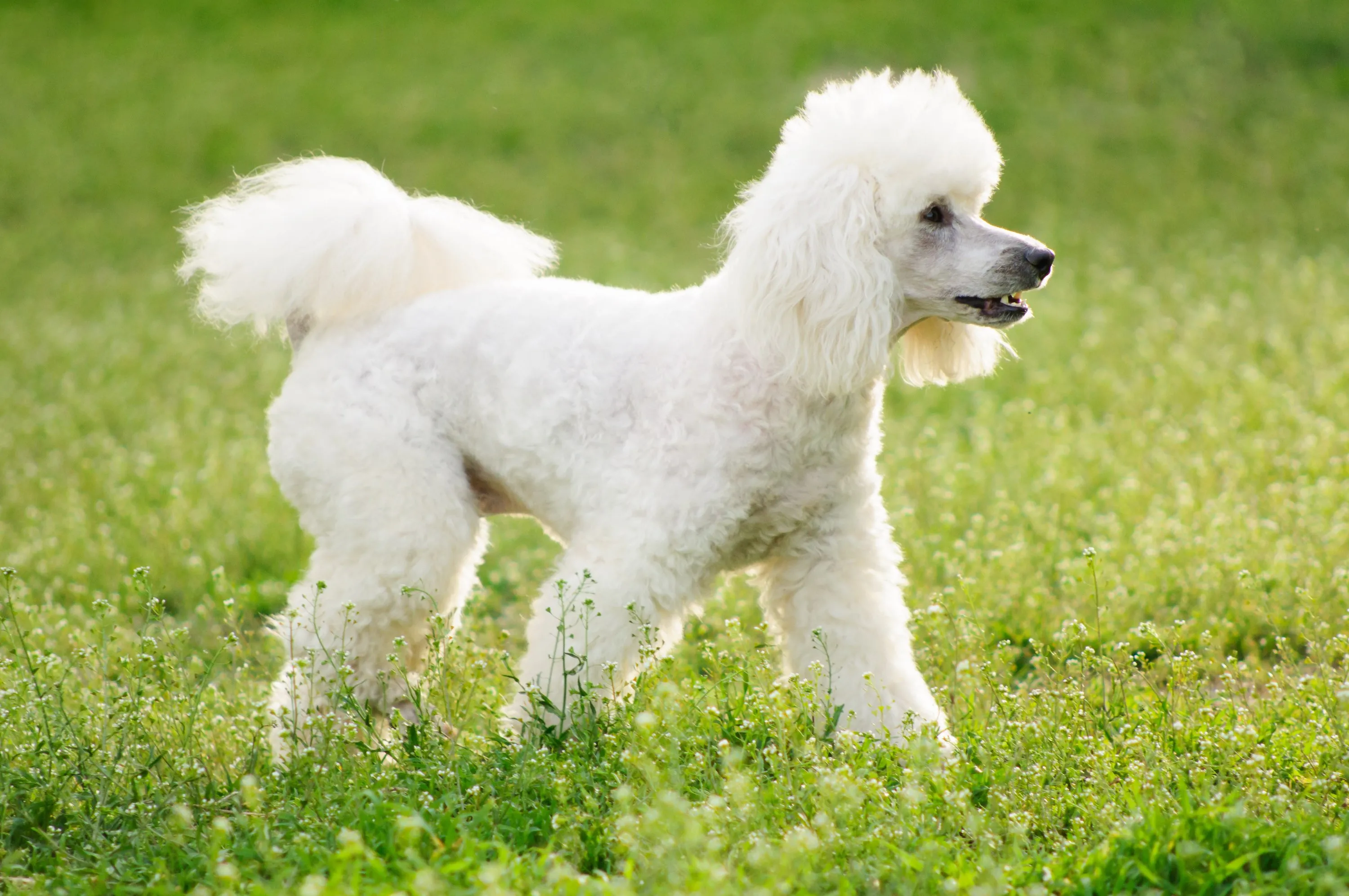 Miniature Poodle walking gracefully in a sunlit park
Miniature Poodle walking gracefully in a sunlit park
Poodles are renowned for their elegant appearance, sharp intelligence, and, most importantly for allergy sufferers, their low-shedding coats. While Standard Poodles are medium to large, both Toy Poodles and Miniature Poodles fall perfectly into the small dog category. Toy Poodles typically stand under 10 inches tall and weigh 4-6 pounds, while Miniature Poodles are 10-15 inches tall and weigh 10-15 pounds. Their curly, dense coats are excellent at trapping dander, preventing it from circulating in the air.
Beyond their allergy-friendly qualities, Poodles are highly intelligent and easily trainable, often excelling in obedience and agility. They possess a playful and affectionate nature, making them wonderful family pets. Despite their low-shedding status, their coats do require regular grooming to prevent matting. This means frequent brushing at home and professional grooming every 4-6 weeks to keep their curls in top condition. Whether you’re considering a playful Toy or a slightly larger, active Miniature, Poodles offer a fantastic combination of brains, beauty, and allergy-friendliness. For those specifically looking for black Miniature Poodles, there are various breeders and rescue organizations to explore. You can find more information on black miniature poodles for sale near me.
2. Yorkshire Terrier
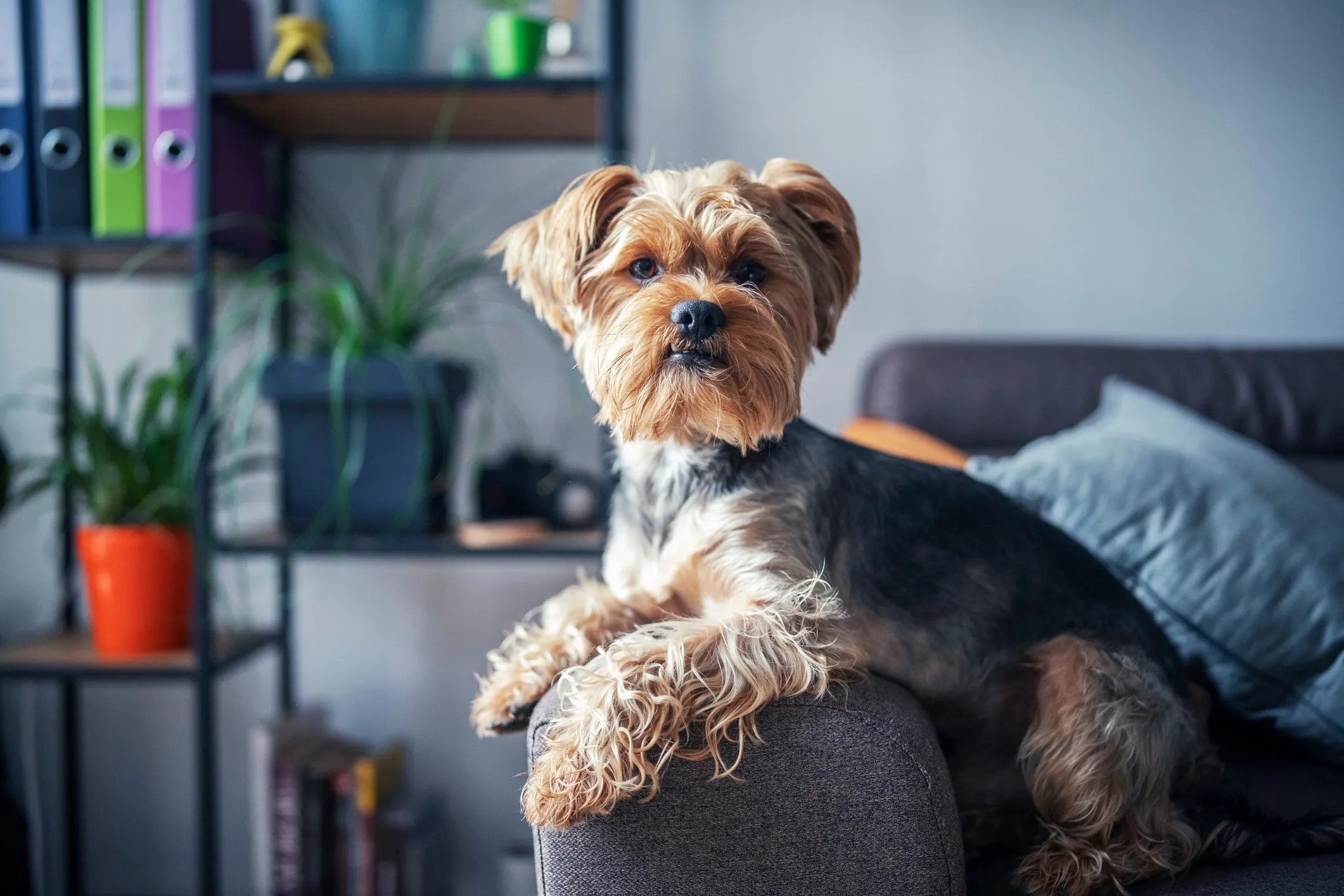 A charming Yorkshire Terrier with blue and tan fur relaxing comfortably on an armchair
A charming Yorkshire Terrier with blue and tan fur relaxing comfortably on an armchair
Affectionately known as “Yorkies,” Yorkshire Terriers are tiny bundles of joy with big personalities. Weighing typically between 4-7 pounds and standing around 7-8 inches tall, they are true lap dogs. Their long, silky, human-like hair is low-shedding, similar to human hair, and contributes minimally to household allergens. This makes them a favored choice among allergy sufferers who prefer a dog with a traditional “hair” coat rather than fur.
Yorkies are spirited, curious, and incredibly loyal to their families. They adapt well to various living environments, from apartments to larger homes, as long as they receive plenty of attention and mental stimulation. While their shedding is minimal, their long coats require daily brushing to prevent tangles and mats. Many owners opt for a shorter “puppy cut” to simplify grooming. Despite their small stature, they are feisty and confident, often unaware of their diminutive size.
3. Shih Tzu
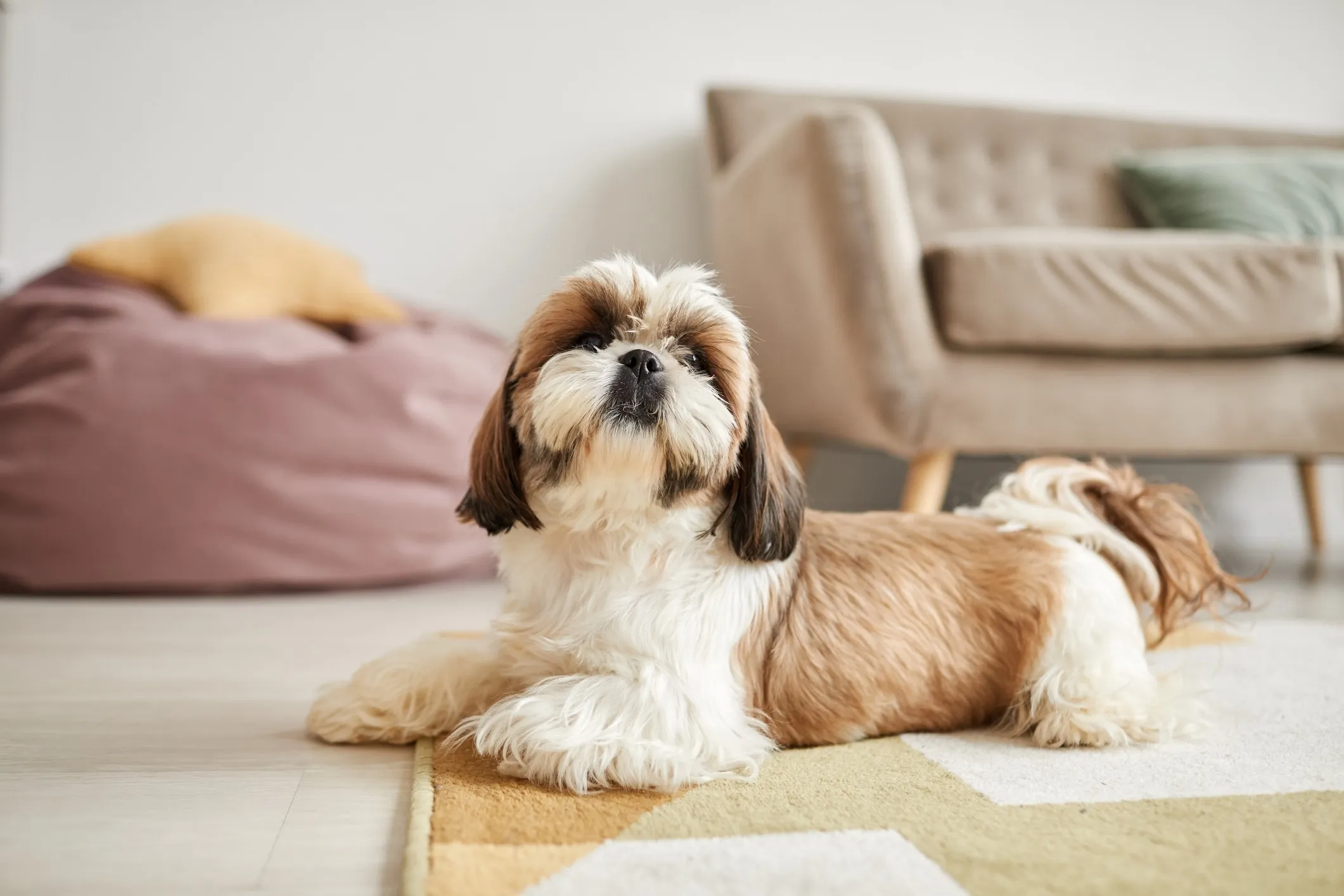 A fluffy brown and white Shih Tzu resting peacefully on a living room floor
A fluffy brown and white Shih Tzu resting peacefully on a living room floor
The Shih Tzu, an ancient companion breed originating from Tibetan monasteries, is cherished for its majestic long coat and friendly disposition. These charming dogs typically weigh 9-16 pounds and stand 9-10.5 inches tall. Their luxurious double coat sheds minimally, trapping dander within its layers. This trait, combined with their affectionate nature, makes them highly sought after by those with allergies.
Shih Tzus are known for their outgoing and charming temperaments, thriving on human companionship. They are generally good with children and other pets, making them excellent family additions. However, their distinctive flat faces (brachycephalic) can predispose them to certain health issues, such as breathing difficulties and overheating in warm weather. Regular grooming, including daily brushing, is essential to keep their long coats free of mats. Many owners choose to keep their Shih Tzus in a shorter cut for easier maintenance and to highlight their cheerful expressions.
4. Miniature Schnauzer
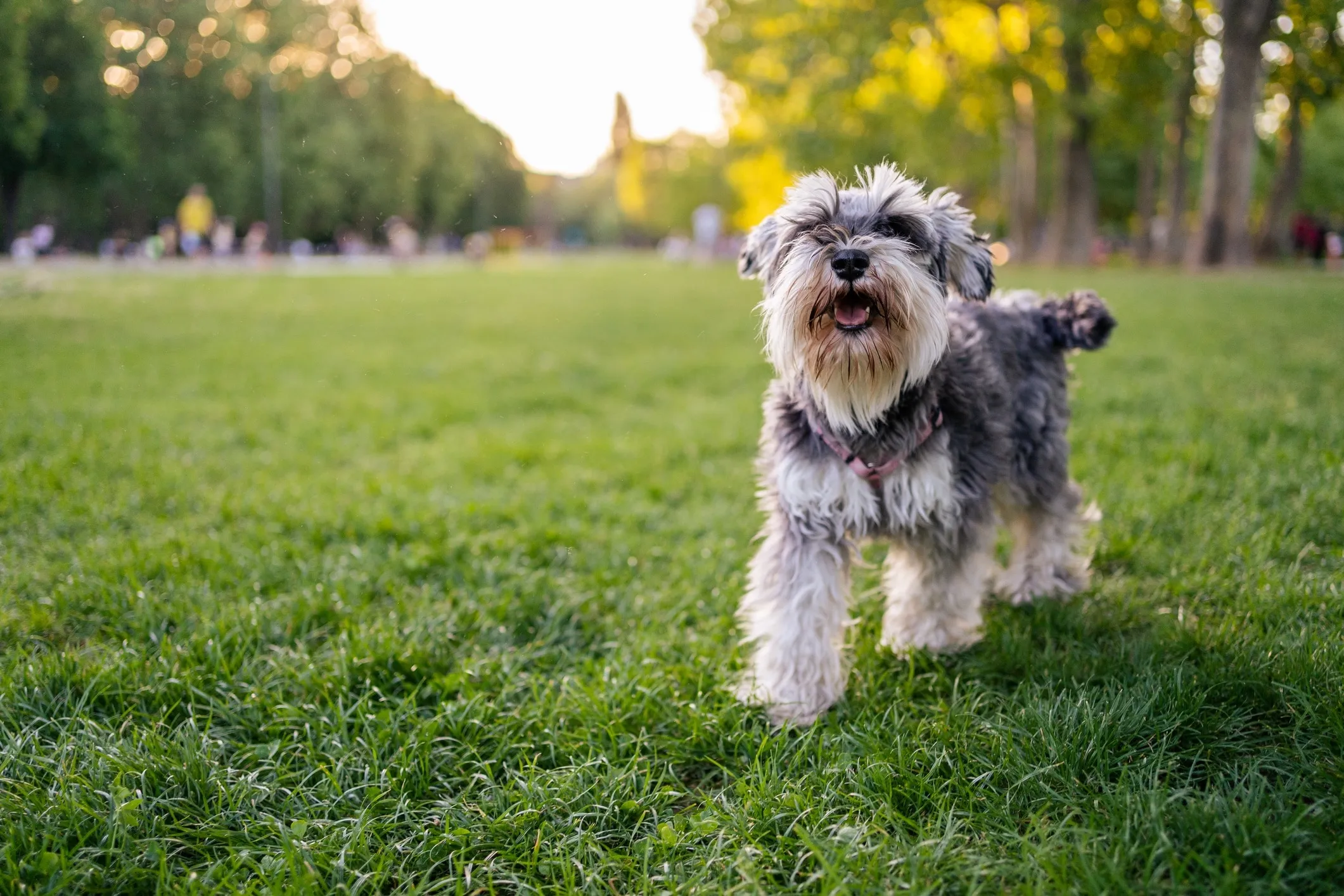 A salt and pepper Miniature Schnauzer wearing a pink harness, looking alert in a vibrant green park
A salt and pepper Miniature Schnauzer wearing a pink harness, looking alert in a vibrant green park
Of the three Schnauzer breeds, the Miniature Schnauzer is the smallest, typically weighing 10-20 pounds and standing 12-14 inches tall. These sturdy, intelligent, and spirited dogs boast a wiry topcoat and a soft undercoat that sheds very little, making them an excellent choice for individuals prone to allergies. Their distinctive facial furnishings – bushy eyebrows and a beard – give them a charming, distinguished look.
Miniature Schnauzers are known for their lively and alert personalities. They are intelligent and eager to please, making them highly trainable. Despite their small size, they have a surprising amount of energy and require at least an hour of daily exercise to stay happy and healthy. Their low-shedding coat needs regular grooming, including brushing several times a week and professional stripping or clipping every 5-8 weeks to maintain its texture and prevent matting. They are adaptable dogs that can thrive in various living environments, from apartments to houses, provided they get sufficient activity and companionship.
5. Bichon Frise
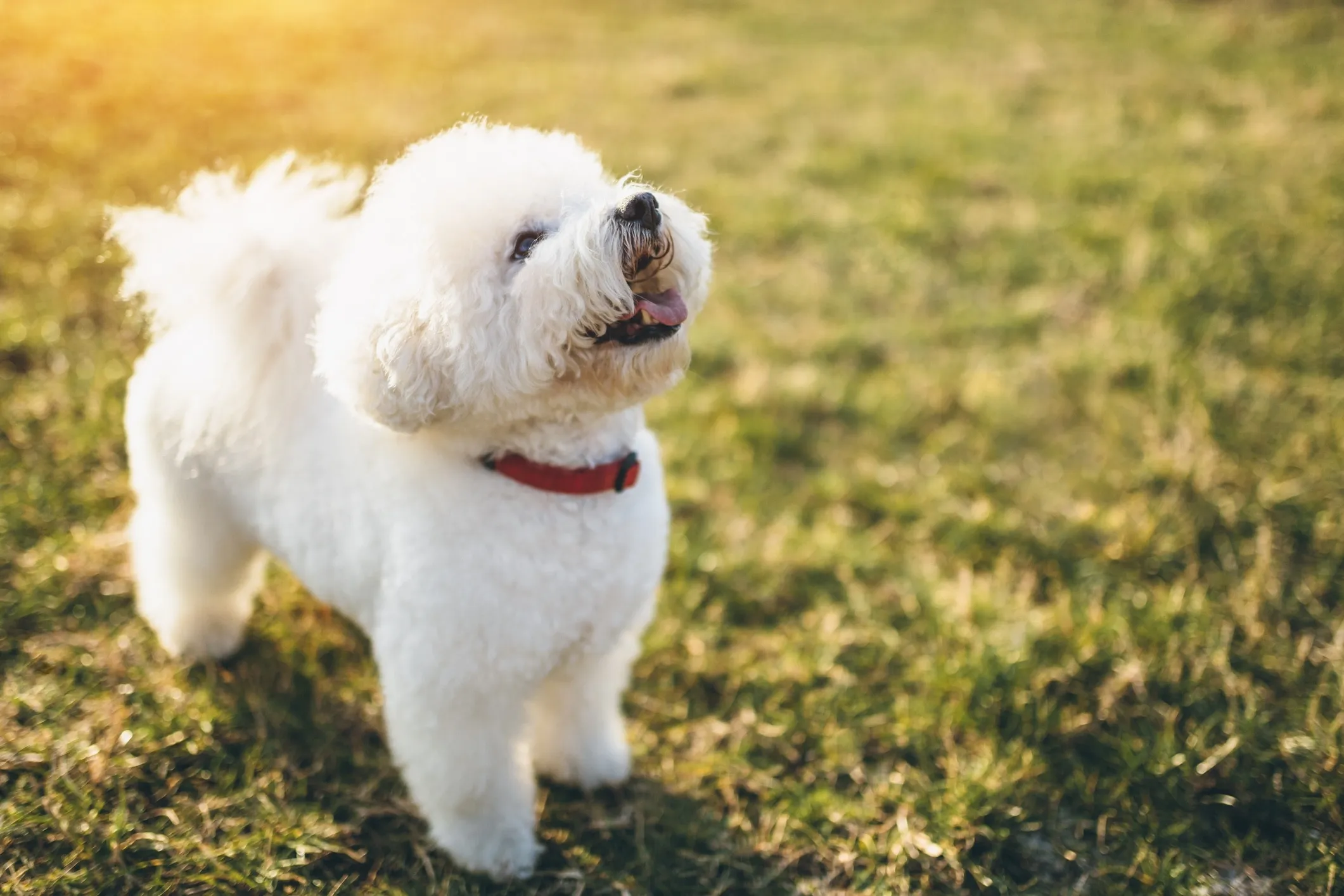 A fluffy white Bichon Frise, with its characteristic curly coat, looking up while sitting in lush green grass
A fluffy white Bichon Frise, with its characteristic curly coat, looking up while sitting in lush green grass
The Bichon Frise is a cheerful, playful, and affectionate small dog, typically weighing 12-18 pounds and standing 9-12 inches tall. Their signature powder-puff coat consists of a soft, curly double layer that sheds minimally, trapping dander close to the skin. This characteristic makes them one of the most popular choices for allergy sufferers.
Bichons are known for their joyful and charming personalities, often described as “little clowns” due to their playful antics. They are highly intelligent and eager to learn, responding well to positive reinforcement training. Their sociable nature means they thrive on being part of the family and generally get along well with children and other pets. Daily brushing is crucial for their curly coats to prevent mats, and professional grooming every 4-6 weeks is recommended to keep them looking their best. With their perpetually happy demeanor and allergy-friendly qualities, Bichons bring immense joy to any home.
6. Chinese Crested
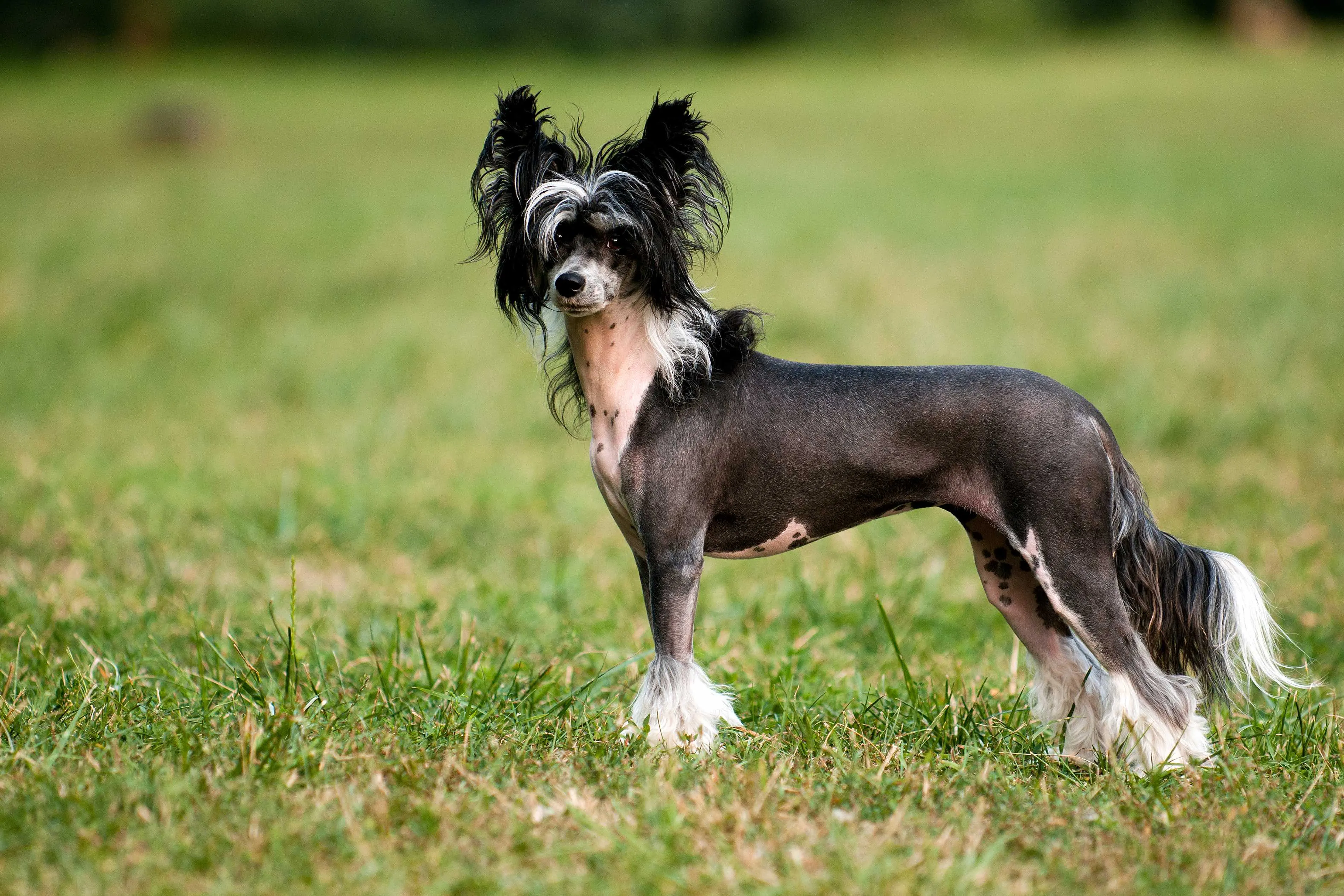 A striking hairless Chinese Crested dog with tufts of dark hair on its head, tail, and paws, looking directly at the camera
A striking hairless Chinese Crested dog with tufts of dark hair on its head, tail, and paws, looking directly at the camera
The Chinese Crested is a truly unique small breed, known for its distinctive appearance. They typically weigh 10-13 pounds and stand 11-13 inches tall. This breed comes in two varieties: the Hairless, which has smooth skin with tufts of hair on its head, tail, and paws; and the Powderpuff, which is covered in a soft, silky coat. Both varieties are considered hypoallergenic. The Hairless variety produces very little dander due to minimal hair, while the Powderpuff’s single coat sheds minimally.
Chinese Cresteds are affectionate, playful, and sensitive companions who thrive on human interaction. They form strong bonds with their families and can be surprisingly good watchdogs despite their small size. The Hairless variety requires skin care, including moisturizing and sun protection, while the Powderpuff needs regular brushing to keep its long coat tangle-free. Their unique looks and loving personalities make them cherished pets for those seeking a small, low-allergen companion.
7. Maltese
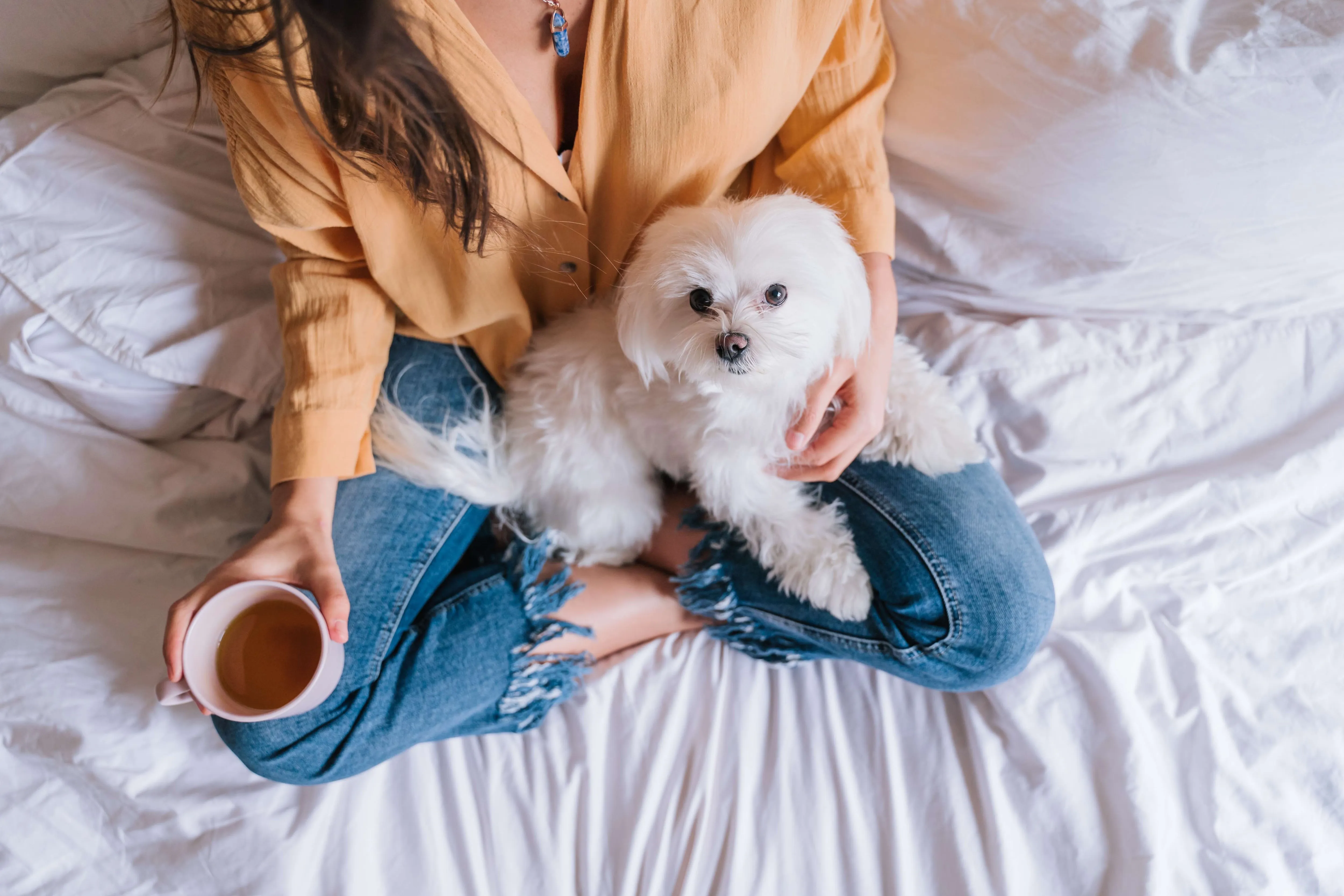 A woman gently holding a pristine white Maltese dog, known for its luxurious coat, on a soft bed
A woman gently holding a pristine white Maltese dog, known for its luxurious coat, on a soft bed
The Maltese is a regal and charming small dog, typically weighing under 7 pounds and standing 7-9 inches tall. Famous for their floor-length, silky white coat, Maltese are elegant companions whose single layer of hair sheds very little, contributing to their reputation as an excellent choice for allergy sufferers. Their low shedding nature is a significant advantage for keeping allergens at bay.
Maltese dogs are affectionate, gentle, and playful. They thrive on companionship and enjoy being close to their humans, making them ideal lap dogs. Despite their delicate appearance, they can be quite spirited and enjoy short bursts of play. Their beautiful white coats require diligent daily brushing to prevent mats and keep them pristine. Many owners opt for a shorter “puppy cut” to reduce grooming time. Maltese are well-suited for apartment living and make devoted companions for individuals or families who can dedicate time to their grooming and attention needs.
8. Coton de Tulear
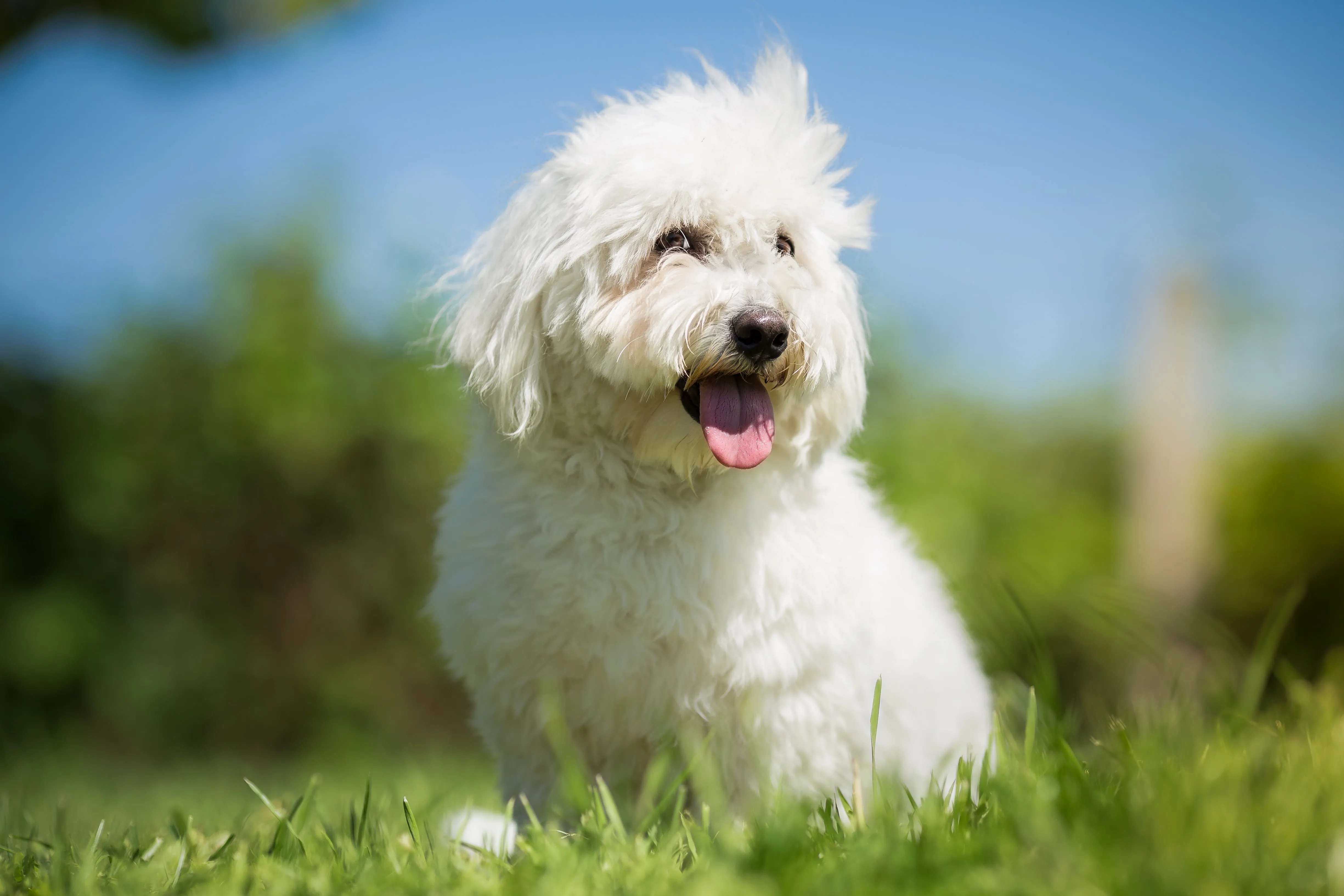 A small, white Coton de Tulear with its fluffy coat softly blowing in the wind, sitting gracefully in green grass
A small, white Coton de Tulear with its fluffy coat softly blowing in the wind, sitting gracefully in green grass
Originating from Madagascar, the Coton de Tulear is a charming and intelligent small dog, typically weighing 8-15 pounds and standing 10-12 inches tall. Their name, derived from “coton” (French for cotton) and Tulear (a port city in Madagascar), perfectly describes their unique, cotton-like coat. This soft, fluffy, low-shedding coat is a single layer, similar to human hair, making them another fantastic option for individuals with allergies.
Cotons are known for their cheerful, sociable, and affectionate personalities. They are often described as “anti-stress dogs” due to their loving and adaptable nature. They get along well with children, other pets, and strangers, thriving in various family settings. While they don’t shed much, their cottony coats do require regular brushing several times a week to prevent tangles and mats. They enjoy playtime and short walks but are generally content to snuggle on the couch with their families.
9. Affenpinscher
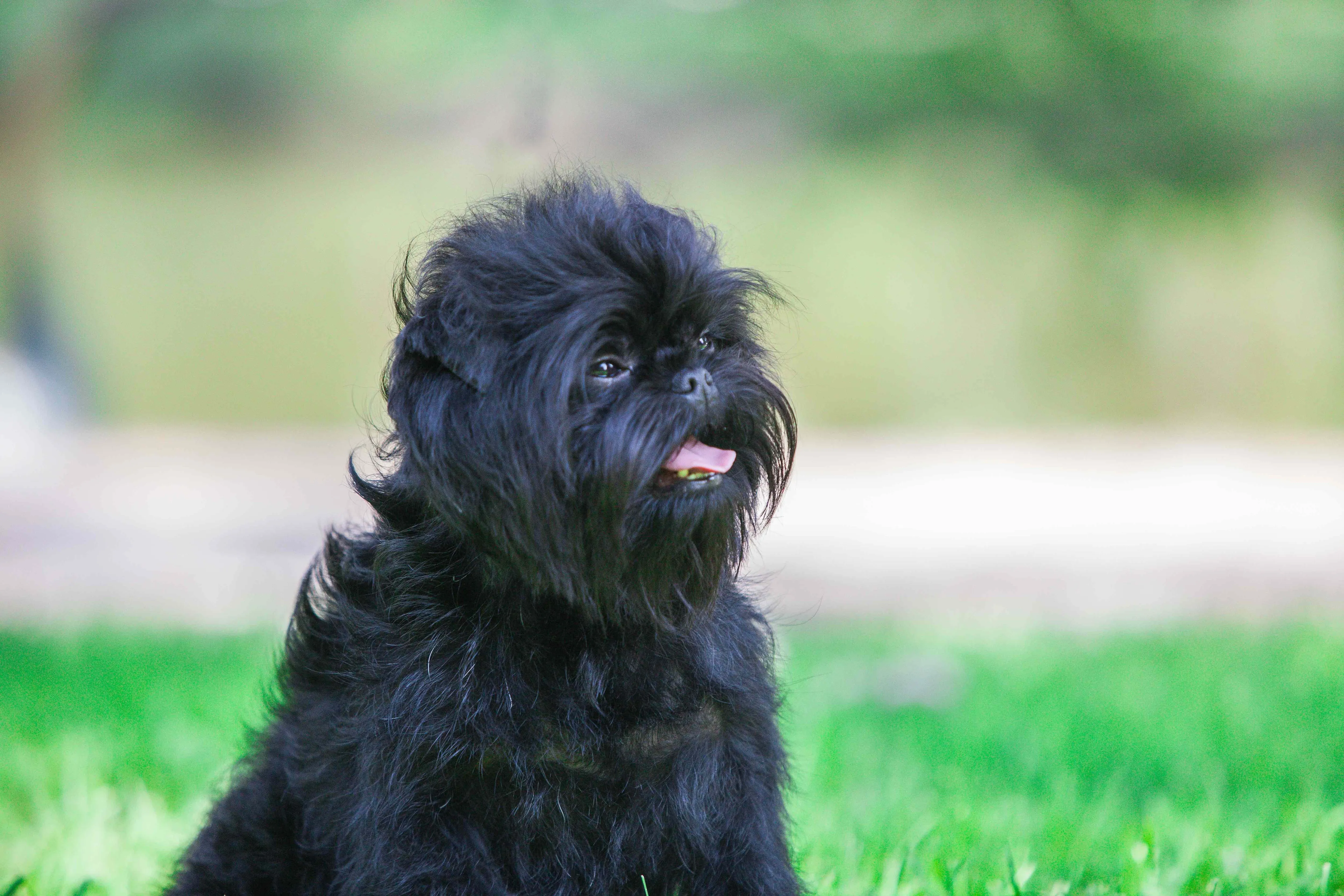 A close-up of a black Affenpinscher dog, showcasing its distinctive monkey-like facial expression and wiry coat
A close-up of a black Affenpinscher dog, showcasing its distinctive monkey-like facial expression and wiry coat
The Affenpinscher, often called the “monkey dog” due to its distinctive facial expression, is a small, lively breed, typically weighing 7-10 pounds and standing 9-11.5 inches tall. Their dense, wiry, and shaggy coat is low-shedding, which is a major benefit for allergy sufferers. This unique texture helps to trap dander and loose hairs, minimizing their release into the environment.
Affenpinschers are known for their confident, mischievous, and curious personalities. They are intelligent and charming, often providing endless entertainment with their playful antics. Despite their small size, they have a courageous spirit and can be surprisingly bold. While they are low-shedding, their wiry coats require regular grooming, including weekly brushing and occasional hand-stripping (a process where dead hair is plucked out by the root) to maintain coat health and texture. Affenpinschers are loyal companions who thrive on being part of their family’s activities, making them excellent apartment dwellers.
10. Bolognese
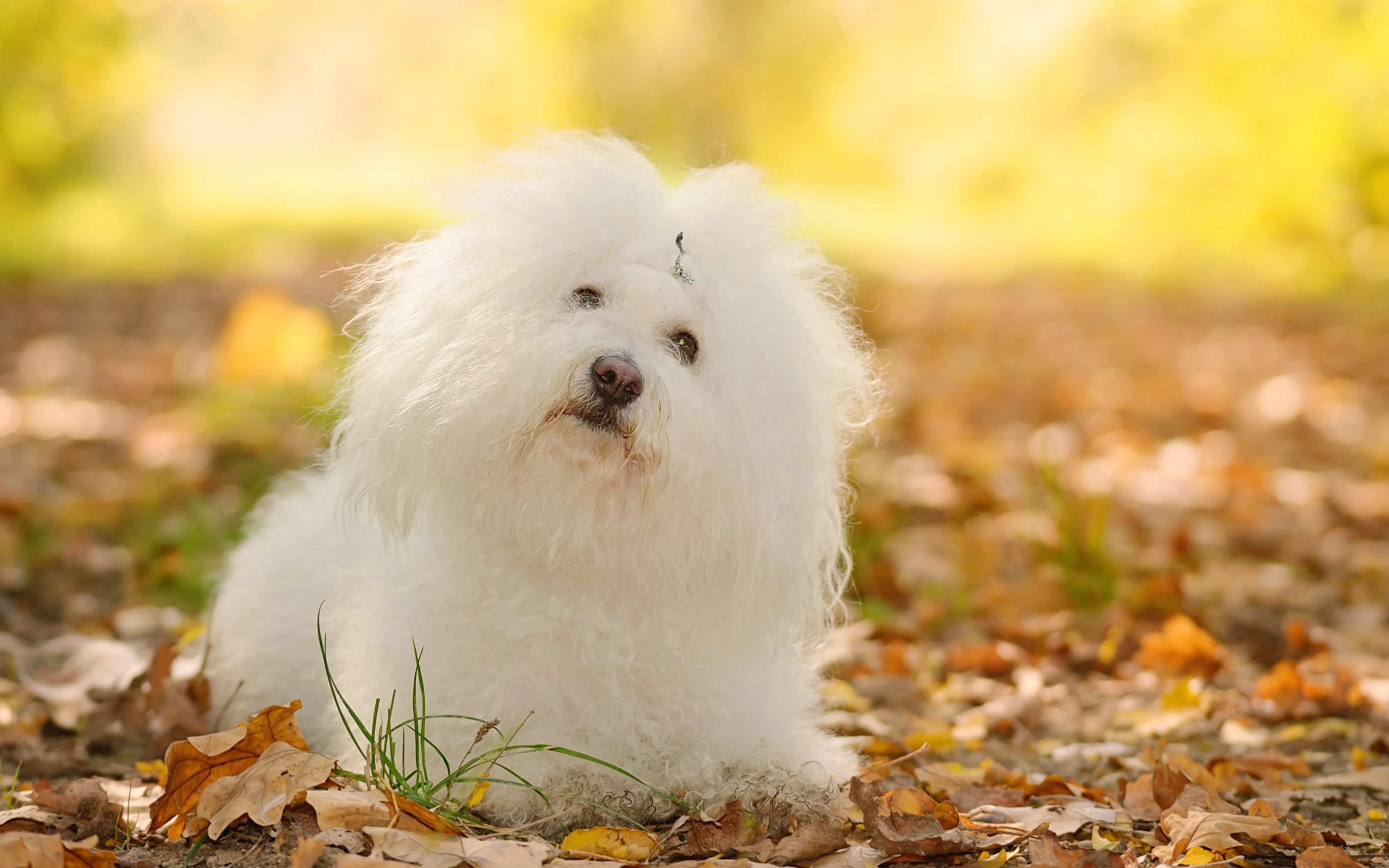 A white Bolognese dog with its characteristic fluffy, curly coat, sitting amidst the warm colors of an autumn forest
A white Bolognese dog with its characteristic fluffy, curly coat, sitting amidst the warm colors of an autumn forest
Hailing from Italy, the Bolognese is a delightful small dog, typically weighing 6.5-10 pounds and standing 10-12 inches tall. Their long, fluffy, pure white coat is non-shedding, similar to other Bichon-type breeds, which makes them an excellent companion for people with allergies. Despite its somewhat messy appearance, this coat traps dander effectively.
Bolognese dogs are known for their calm, playful, and easygoing temperaments. They form strong bonds with their families and are content to be close to their humans, whether it’s lounging on the couch or joining them on short walks. They are generally good with children and other pets, adapting well to various living situations. While they don’t shed, their unique cottony coats require dedicated grooming, including daily brushing to prevent matting and professional grooming as needed to keep their distinctive look.
11. Bedlington Terrier
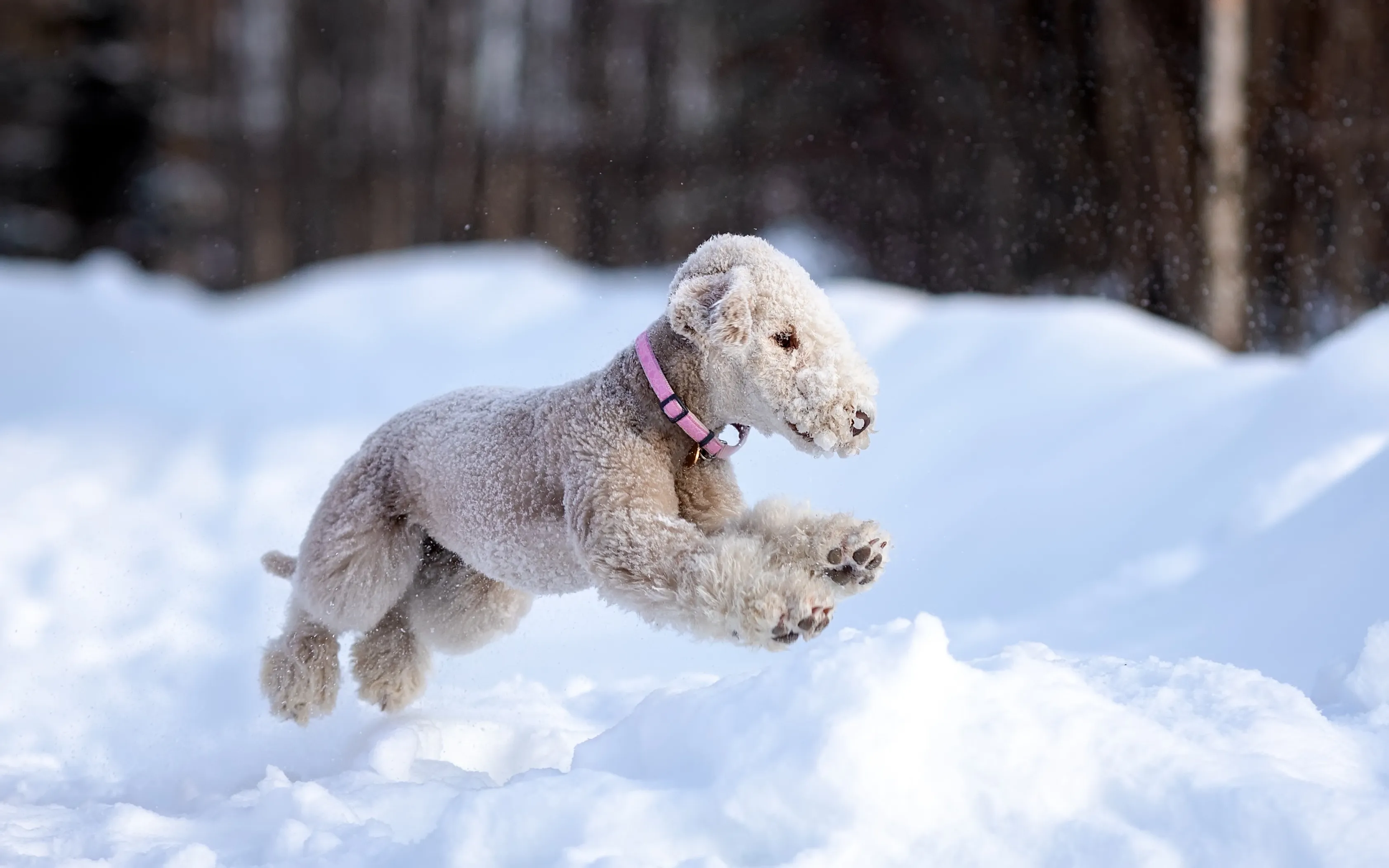 A graceful white Bedlington Terrier, known for its lamb-like appearance, running through fresh snow with enthusiasm
A graceful white Bedlington Terrier, known for its lamb-like appearance, running through fresh snow with enthusiasm
Often described as “a lamb in dog’s clothing,” the Bedlington Terrier is a small to medium-sized breed, with the smallest individuals fitting into the small category, weighing 17-23 pounds and standing 15-17.5 inches tall. Their distinctive curly, woolly coat is virtually non-shedding, making them a fantastic option for allergy sufferers. This unique coat texture, combined with their arched back and topknot, gives them a unique and elegant silhouette.
Bedlington Terriers are charming, intelligent, and affectionate dogs. They are lively and playful, possessing the typical terrier spirit, and require regular exercise to channel their energy. They bond deeply with their families and thrive on companionship, sometimes developing separation anxiety if left alone for extended periods. Their low-shedding coats require regular professional grooming (every 6-8 weeks) and weekly brushing at home to prevent matting and maintain their signature appearance.
12. Xoloitzcuintli (Toy and Miniature)
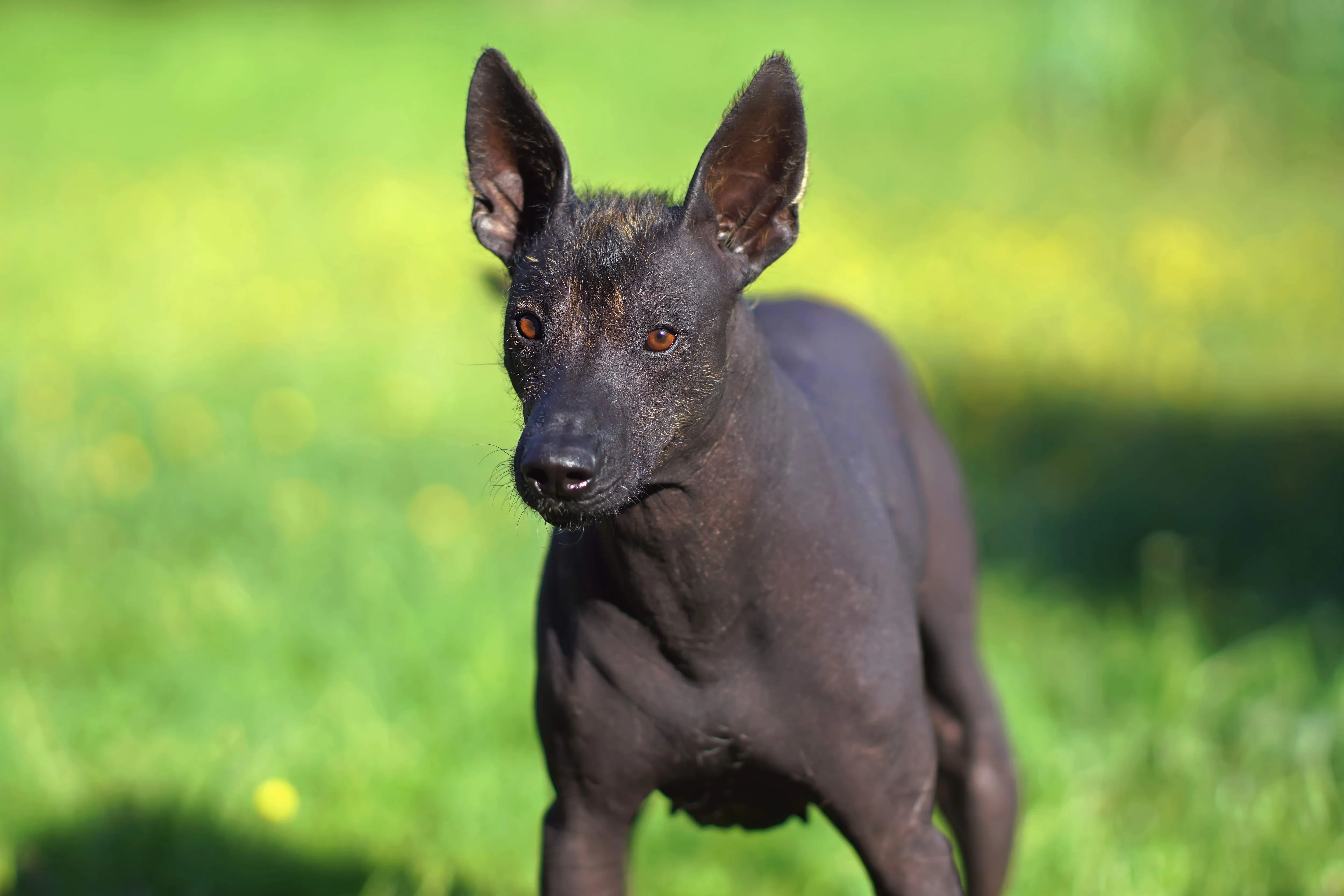 A sleek black Hairless Xoloitzcuintli, an ancient Mexican breed, standing gracefully in green grass
A sleek black Hairless Xoloitzcuintli, an ancient Mexican breed, standing gracefully in green grass
The Xoloitzcuintli, or Mexican Hairless Dog, is an ancient and rare breed that comes in three sizes: Toy (under 14 inches, 10-15 pounds), Miniature (14-18 inches, 15-30 pounds), and Standard. For those focusing on small, non-shedding dogs, the Toy and Miniature varieties are excellent choices. As their name suggests, the hairless variety has smooth, soft skin with minimal to no hair, making them inherently low in dander and virtually shed-free. There is also a coated variety with a short, smooth coat that also sheds minimally.
Xolos are known for being calm, loyal, and intelligent companions. They form strong bonds with their families and can be surprisingly protective. They are generally clean dogs and, despite their hairless appearance, require specific skincare, including regular moisturizing and sun protection. Their unique history and allergy-friendly qualities make them fascinating and loving pets.
13. Shorkie
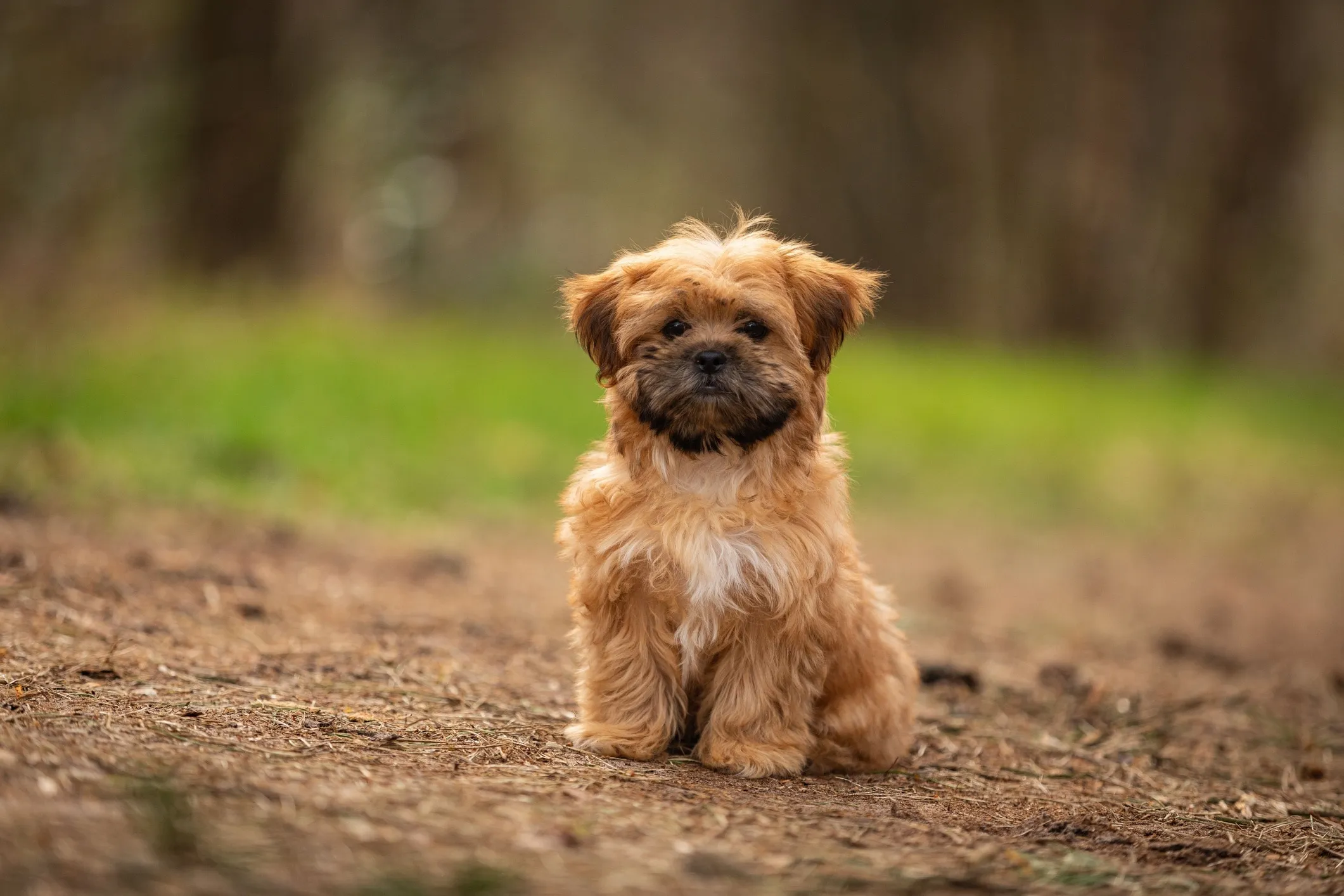 A small, tan and black Shorkie mix dog sitting alertly on a hiking trail, showcasing its blended features
A small, tan and black Shorkie mix dog sitting alertly on a hiking trail, showcasing its blended features
The Shorkie is a delightful mixed breed, a cross between two hypoallergenic dogs: the Shih Tzu and the Yorkshire Terrier. This combination typically results in a small, low-shedding dog that inherits the best traits of both parent breeds. Shorkies usually weigh between 5-12 pounds and are around 6-14 inches tall, making them ideal for small living spaces.
Shorkies are known for their playful, affectionate, and sometimes sassy personalities. They are intelligent and can be quite entertaining, thriving on human companionship. Like their parent breeds, Shorkies require regular grooming to maintain their long, silky coats and prevent matting, even though they shed minimally. Daily brushing is often necessary, and many owners opt for professional grooming every few weeks to keep their coats tidy. These charming little dogs make wonderful, low-allergen family pets for those seeking a small, lively companion. We are glad to offer you more pictures of small dogs that don t shed throughout this article.
14. Shih-Poo
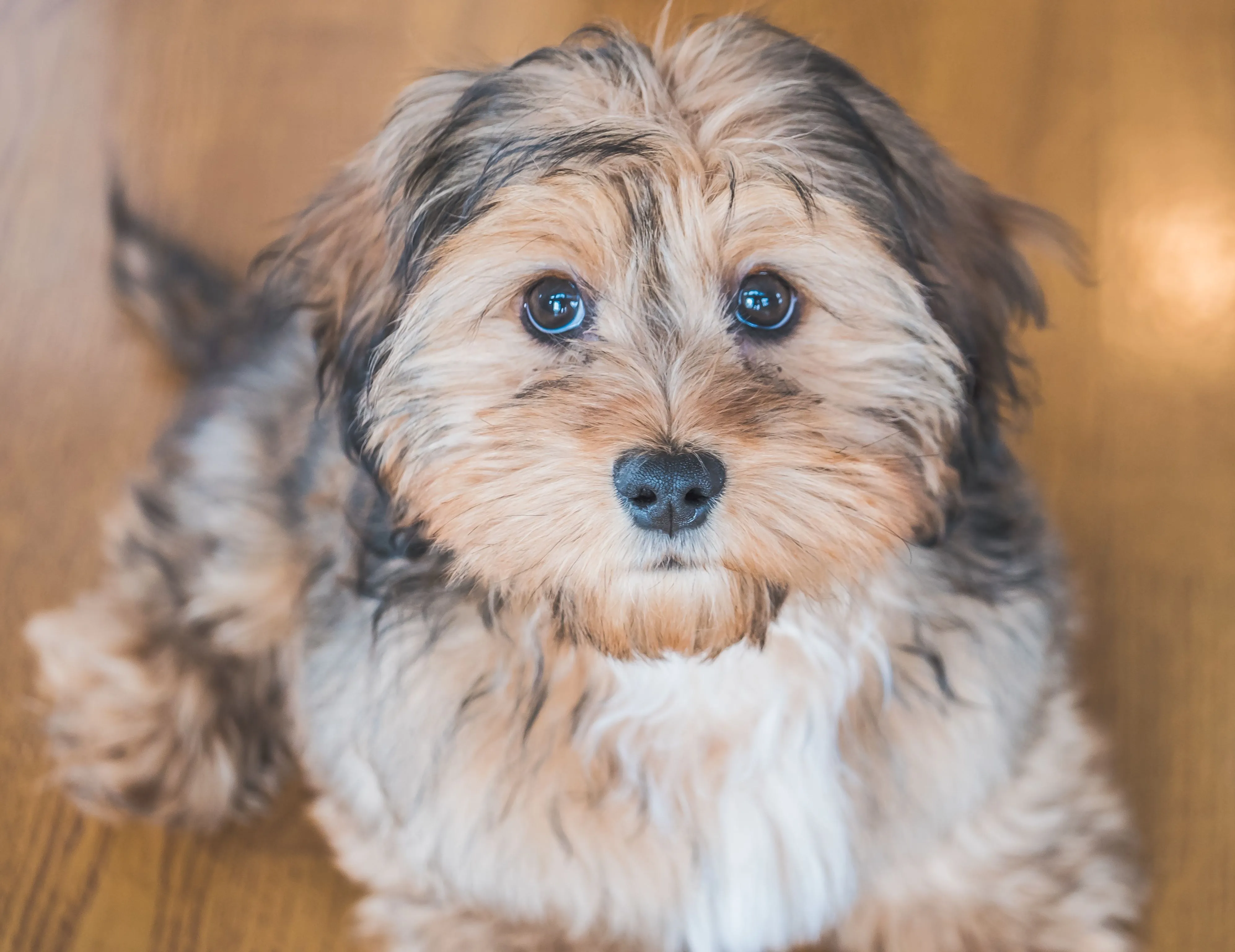 A close-up of a tan and black Shih-Poo dog, a mix of Shih Tzu and Poodle, with its wavy, soft coat
A close-up of a tan and black Shih-Poo dog, a mix of Shih Tzu and Poodle, with its wavy, soft coat
The Shih-Poo is another popular designer crossbreed, combining the friendly nature of the Shih Tzu with the intelligence of the Poodle (most commonly the Toy or Miniature Poodle). This mix results in a small dog, typically weighing 8-15 pounds and standing 8-13 inches tall, with a wavy or curly coat that is very low-shedding and allergy-friendly.
Shih-Poos are known for their cheerful, outgoing, and affectionate personalities. They are often described as “lap dogs” who thrive on attention and being part of family activities. Their intelligence makes them relatively easy to train, and they generally get along well with children and other pets. While their low-shedding coats mean less hair around the house, they still require regular grooming, including daily brushing to prevent tangles and professional grooming every 4-8 weeks, depending on the coat length preferred by the owner. Shih-Poos are adaptable and can do well in almost any living situation, making them a popular choice for apartment dwellers and first-time dog owners alike.
15. Malshi
 A tri-color Malshi dog, a cross between a Maltese and Shih Tzu, sitting attentively in vibrant green grass
A tri-color Malshi dog, a cross between a Maltese and Shih Tzu, sitting attentively in vibrant green grass
The Malshi is a charming and happy crossbreed between a Maltese and a Shih Tzu. Typically weighing 6-12 pounds and standing 6-14 inches tall, Malshis are small, affectionate dogs known for their low-shedding, fluffy coats, which makes them ideal for allergy sufferers. They inherit the best traits from both beloved parent breeds, offering a delightful mix of playfulness and devotion.
Malshis thrive on close companionship and are happiest when they are surrounded by their favorite humans. They are known for their gentle, sweet, and lively personalities, making them wonderful family pets. While they require plenty of attention, their moderate exercise needs can be met with daily walks and indoor play. Their long, soft coats, though low-shedding, require regular grooming – daily brushing is often necessary to prevent tangles and mats, and professional grooming every few weeks can help maintain their tidy appearance. Malshis are well-suited for apartment living and bring immense joy and cuddles to their homes.
Caring for Your Small, Non-Shedding Companion
Bringing a low-shedding small dog into your home is a fantastic step toward managing allergies, but it’s important to remember that they still require specific care to minimize allergens and keep them healthy.
Grooming Essentials
Even though these breeds are low-shedding, they are not maintenance-free. Their unique coats often require more frequent grooming than shedding breeds to prevent matting and to remove any trapped dander.
- Regular Brushing: Most low-shedding breeds need to be brushed daily or every other day. This helps to remove loose hair and dander from their coats before it can disperse into your home. It also prevents painful mats and tangles.
- Bathing: Regular bathing, typically every 2-4 weeks (or as advised by your vet), helps to wash away dander and allergens from their skin and coat. Use a gentle, hypoallergenic dog shampoo to avoid irritating their skin. Products like Allerpet® Dog Dander Remover can also be effective in reducing allergens.
- Professional Grooming: Many non-shedding breeds, especially those with curly or long coats, benefit from professional grooming every 4-8 weeks. Groomers can provide specialized cuts, trimming, and dematting services that are crucial for maintaining coat health. If you plan to groom at home, invest in quality tools like clippers and slicker brushes suitable for their coat type.
Maintaining a Clean Home Environment
Grooming your dog is only half the battle. Maintaining a clean home is equally important to minimize allergens.
- Frequent Vacuuming: Vacuum carpets, rugs, and upholstery frequently, ideally with a vacuum cleaner equipped with a HEPA filter, to capture pet dander.
- Dusting and Washing: Regularly dust surfaces and wash bedding (yours and your dog’s) in hot water. Consider allergen-proof covers for pillows and mattresses.
- Air Purification: Using high-efficiency particulate air (HEPA) filters in your vacuum cleaner and home air purifiers can significantly reduce airborne allergens.
- Designated Dog Areas: Consider keeping your dog out of certain rooms, like bedrooms, to create allergen-free zones, especially where you sleep.
Health and Well-being
Beyond grooming and cleanliness, ensuring your small, non-shedding dog’s overall health is paramount. A healthy dog generally produces less dander.
- Regular Vet Check-ups: Routine veterinary visits are essential for preventing and addressing any health issues, including skin conditions that could lead to increased dander.
- Nutrition: Feed your dog a high-quality, balanced diet appropriate for their size and activity level. Good nutrition contributes to healthy skin and coat.
- Exercise: Even small dogs need regular exercise. This helps maintain a healthy weight, strengthens their immune system, and reduces stress, which can sometimes impact skin health. Tailor exercise to their breed-specific needs.
- Socialization and Training: A well-adjusted, mentally stimulated dog is a happier dog. Early socialization and consistent training are important for all breeds, ensuring they are calm and less stressed, which can indirectly affect dander production.
Living with Allergies: Consulting Your Doctor
While a low-shedding dog can greatly improve life for allergy sufferers, it’s always wise to consult with your healthcare provider. Your doctor can offer personalized advice on managing your allergies, which might include medications, nasal sprays, or allergy shots. Combining responsible pet ownership with medical guidance provides the most effective approach to enjoying life with your furry friend without constant allergic reactions.
Conclusion
Choosing a small dog that doesn’t shed offers a fantastic pathway for allergy sufferers to experience the unconditional love and companionship of a canine pet. Breeds like the Poodle, Yorkshire Terrier, Shih Tzu, Bichon Frise, and Miniature Schnauzer, among others, bring unique personalities and charm into homes, proving that great things truly come in small, low-shedding packages. While no dog is entirely “hypoallergenic,” these breeds significantly reduce allergen exposure, making a harmonious life possible.
Remember, the key to success lies in a combination of selecting the right breed, committing to consistent grooming, maintaining a clean living environment, and consulting with your doctor for allergy management. By taking these steps, you can confidently welcome one of these delightful small, non-shedding dogs into your family and enjoy all the wonderful moments of pet parenthood, free from the constant worry of allergic reactions. Explore the vast world of dog care further with our comprehensive resources at Dog Care Story!
WRITTEN BY
Nicole Zittritsch, LVT, BSc, MPH
Veterinarian Technician
